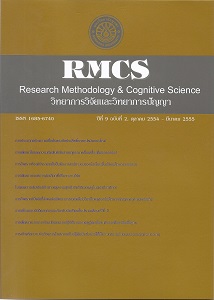การเข้ารหัสความจําด้วยการจินตภาพเชิงปฏิสัมพันธ์จากวลี ที่มีความหมายช่วยลดความแตกต่างทางอายุ ในการจําความสัมพันธ์คู่ใบหน้ากับชื่อ
Main Article Content
Abstract
การจําความสัมพันธ์ได้หมายถึงความสามารถในการจําได้ว่ารายการที่ต้องจําจํานวนสองรายการหรือมากกว่านั้น เคยปรากฏ ร่วมกันมาก่อน ผู้สูงอายุมีความลําบากในการเชื่อมโยงข้อมูลที่แตกต่างกันเข้าไว้เป็นภาพความจําเดียวกันได้ Naveh-Benjamin (2000) ได้เสนอสมมติฐานการจําความสัมพันธ์บกพร่องในผู้สูงอายุการบกพร่องนี้เกิดจากความสามารถในการจําด้วยการระลึกได้ลดลง ซึ่งเป็นผล มาจากปริมาตรของเนื้อสมองสวนฮิบโปแคมปัสลดลงมีผลงานวิจัยที่น่าเชื่อถือได้ว่าการพร่องการจำความสัมพันธ์คู่ใบหน้ากับชื่อมีความสัมพันธ์ กับอายุที่เพิ่มขึ้น แต่อย่างไรก็ตามความบกพร่องนี้สามารถชดเชยให้ดีขึ้นได้ด้วยกลยุทธ์ในการเข้ารหัสความจําที่มีประสิทธิภาพ การศึกษา ที่ผ่านมาแสดงว่าอายมีอิทธิ พลต่อความจำในระดับที่ แตกต่างกันขึ้นอยู่กับกลยุทธที่ใช้ในการสร้างความสัมพันธ์ ขณะเข้ารหัสความจำซึ่งหาก มีการสร้างความหมายให้สิ่งเร้าความจําจะช่วยให้การจําความสัมพันธ์ดีขึ้น เพราะผลของการจําอย่างมีความหมายต่อการกู้คืนความจํา เหตุการณ์มีความเกี่ยวข้องกับระดับของกระบวนการการจัดการข้อมูลซึ่งส่งผลให้จําเหตุการณ์ได้ด้วยการกู้คืนความจําจากความคุ้นเคย
การศึกษาใช้กิจกรรมการจำความสัมพันธ์คู่ใบหน้ากับชื่อ ในกลุ่มตัวอย่างวัยรุ่นและผู้สูงอายที่มีสุขภาพดีกลุ่มละ 15 คน กิจกรรมนี้ ใช้รูปแบบการจําได้ในเวลาต่อมา ประกอบด้วยระยะศึกษาและระยะทดสอบ จํานวน 2 ตอน ในตอนแรกกลุ่มตัวอย่างทั้งสองกลุ่มจะต้องเข้า รหัสความจำาคํ ใบหน้ากับชื่อด้วยวิธีการสร้างจินตภาพเชิงปฏิสัมพันธ์ด้วยตนเอง แต่ในตอนทสองเป็นการเข้ารหัสความจำด้วยวิธีการจินตภาพ เชิงปฏิสัมพันธ์จากวลีที่มีความหมายในระยะทดสอบของทั้งสองตอนเป็นการทดสอบการจําความสัมพันธ์ได้ด้วยวิธีมาตรฐาน ที่ต้องการให้ กลุ่มตัวอย่างจําแนกคู่ใบหน้ากับชื่อที่ปรากฏคู่กันว่าเป็นคู่เก่าคู่ผสมหรือคู่ใหม่ความสามารถในการจําความสัมพันธ์ได้คํานวณมาจากการนํา สัดส่วนในการตอบคู่ใบหน้ากับชื่อที่เป็นคู่เก่าได้ถูกต้อง ลบออกจากสัดส่วนในการตอบว่าคู่ผสมเป็นคู่เก่า การทดสอบความแปรปรวนโดย การวัดซํ้าสองทางชี้ให้เห็นว่ามปฏิสัมพันธ์ระหว่างอายุวัยรุ่นกับผู้สูงอายุกับวิธีการเข้ารหัสความจําแสดงให้เห็นว่าขนาดของความแตกต่าง ทางอายุลดน้อยลง เมื่อเข้ารหัสความจําคู่ใบหน้ากับชื่อด้วยวิธีการจินตภาพเชิงปฏิสัมพันธ์จากวลีที่มีความหมายเมื่อเทียบกับการจินตภาพ เชิงปฏิสัมพันธ์ด้วยตนเอง ซึ่งเป็นการสะท้อนให้เห็นความสําคัญของกลยุทธในการเข้ารหัสคู่ใบหน้ากับชื่อนี้กับความบกพร่องในผู้สูงอายุ
The Semantic Phrase Guided Interactive Imagery Encoding Reduced Age-Related Difference in Face-Name Associative Recognition Memory
Churairat Duangchan, Prawit Thongchai and Seree Chadcham
Centre of Excellence in Cognitive Science College of Research Methodology and Cognitive Science, Burapha University, Thailand
Associative recognition refers to the ability of recognizing that two or more items have previously occurred together. Older adult exhibit diffi culty binding unites of information together into a single memory trace. Naveh-Benjamin (2000) has proposed an Associative Defi cit Hypothesis (ADH) of aging. This defi cit is assumed to the result from a reduction of recollection due to a disproportionally large loss of hippocampal volumes. There were well-established fi ndings of age-related decline in face-name associative recognition memory. However, older adults may successfully compensate their lower memory performance for this unrelated association by effective encoding strategies. The current study examined whether the magnitude of age differences depend on the encoding strategies of the association forming. Specifi cally, because of the infl uence of semantic memory on episodic retrieval was “Levels of Processing (LOP)”, associative recognition was enhanced when stimuli were processed in a semantically meaningful way. The semantic organization of information infl uenced the engagement of episodic memory by modulating familiarity based retrieval.
Fifteen younger and 15 older healthy adults were given face-name associative recognition tasks; it was a subsequent memory paradigm (two study-test blocks). In fi rst block, participants performed to encoding face-name pairs using self generated interactive imagery encoding. In contrast, the second block was a given semantic phrase guided interactive imagery encoding. In test phases of both block, we used a standard recognition memory test that required the participants to discriminate old from recombined and new pairs. The associative recognition memory performance was calculated as the proportion correct of old pairs endorsed (Hit) minus the proportion of recombined pairs endorsed with old pairs (False Alarm). The age group x encoding condition repeated measures analysis of variance (repeated ANOVA), it was a signifi cant age group and encoding condition interaction, revealing a smaller age-related difference favoring the older adult in semantic phrase guided than self generated interactive imagery encodings, highlighting the importance of this face-name pairs encoding strategy and theirs defi cit in older adults.
